#black tortoiseshell blotched tabby
Note
If you're able to tell me anything about the patterns for two of my cats I'd love you. Idk what to call their patterns.





They are both very nice black tortoiseshell tabbies. The shorter haired is black tortie blotched tabby, the longer is black tortie mackerel tabby, i think, based on the last picture 😸 (Blotched or classic is when the cat has swirly patterns on their sides, mackerel is when it's vertically striped.)
#ask and answer#cats#cat analysis#black tortoiseshell tabby#black tortoiseshell mackerel tabby#black tortoiseshell blotched tabby#colors side by side
23 notes
·
View notes
Note
what cat is my funky little gal

Black blotched tortoiseshell tabby with white
#cannedchipps#identifying asks#black tortoiseshell#tabby tortoiseshell#blotched tabby#with white#white spotting
4 notes
·
View notes
Note
How do you tell if a cat is a bengal or a regular tabby?
Rosettes.


The bengal modifier gene turns the spotted tabby pattern, demonstrated by a Savannah in the top image, into rosettes as demonstrated by the Bengal in the bottom picture.
Bengals are the only rosetted breed.

You can also find Bengal’s with similar single spotting to other breeds but it isn’t very common because the rosettes are more desirable.

A Bengsl from Liberty Bengals sporting a single spotted pattern. You can see that the facial structure is still very distinct, though.
Black Rosetted Tabby is by far the most popular color and pattern in the Bengal breed, but it isn’t the only color. You can find self/solid Bengal’s referred to as “melanistic,” but the underlying rosetted pattern is usually still pretty noticeable.

As demonstrated by this Bengal from Benlaria.
Bengal’s also come in a marbled pattern, which is classic tabby wity the bengal modifier gene.

Most often the classic tabby patterns forms what is called a “bulls eye,” referring to the blotch in the center surrounded by the thick striping rippling outwards. Demonstrated here on a Kurilian Bobtail.
This is not desireable in the Bengal breed. Although it may occur it is not a trait that breeders try to preserve and is actively being bred away from in the breed.

Bengal cats also come in point, mink and sepia all referred to as “snow” and charcoal. In snow Bengal’s you can still pretty reliably use the pattern as a guide, it usually shows through pretty distinctly even starting from a young age.
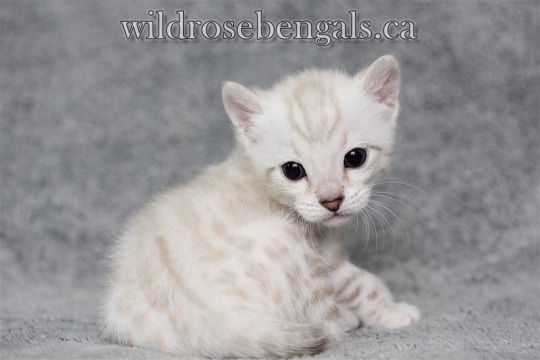
This Wildrose snow lynx Bengal sports itty bitty baby rosettes.
Charcoal only naturally occurs in the Bengal breed… but has been introduced into other breeds through outcross programs, such as the British Shorthair and Oriental Shorthair. These breeds have wildly different conformation than the Bengal so mistaken identity isn’t likely to be an issue.
Charcoal-like patterns have been documented as naturally occuring in random-bred cats but few and far between and without knowing if it’s actually the same gene responsible or something else is going on.

And charcoal will still be paired with a tabby pattern so you can still lean on that, as seen on this silver charcoal from Carbon Cat.
Bengal’s only come in black and blue. A small sample of breeders work with chocolate and cinnamon in the breed (as well as their dilutes) and a selection of breeders have begun to introduce red and tortoiseshell into the breed…
But these are rare enough that if you have a cat in one of those colors that doesn’t have a known lineage relating to one of these breeders cats I’m generally pretty comfortable saying you’re not looking at a Bengal.
Bengal Colors and Patterns
Colours and Patterns of the Bengal Cat
Obviously there is more to the breed standard that just coat color and patterns but they have such distinct, unique markings and coloration that for the layperson this is going to be the easiest way to distinguish a Bengal compared to an ordinary type instead of trying to look at facial conformation and such.
114 notes
·
View notes
Text
Piebald in Cats
White spotting grades
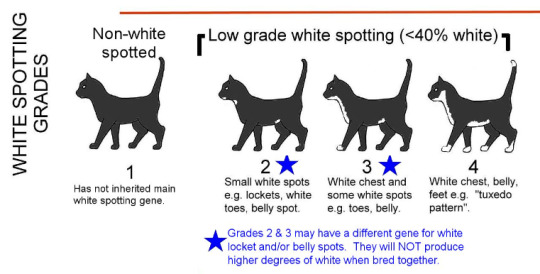
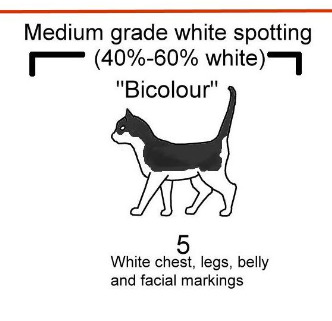
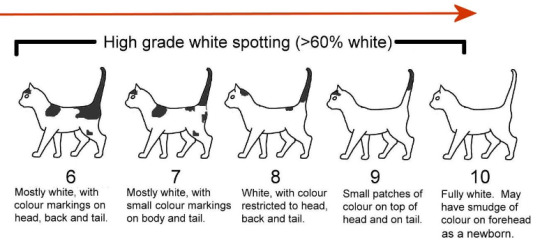
Eye colors + colloquial terms
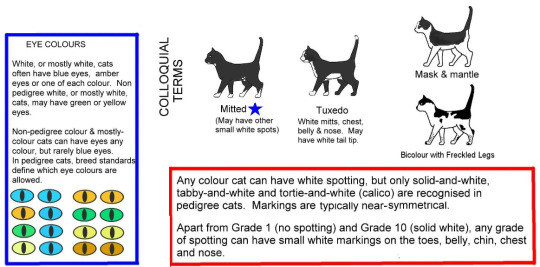
EYE COLOURS
White, or mostly white, cats often have blue eyes, amber eyes or one of each colour. Non pedigree white, or mostly white cats, may have green or yellow eyes.
Non-pedigree colour & mostly-colour cats can have eyes any colour, but rarely blue eyes. In pedigree cats, breed standards define which eye colours are allowed.
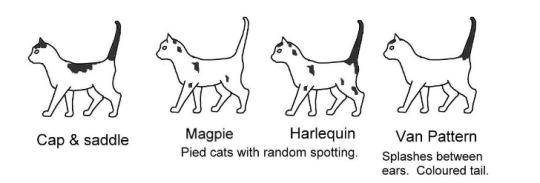
Geneticist terms
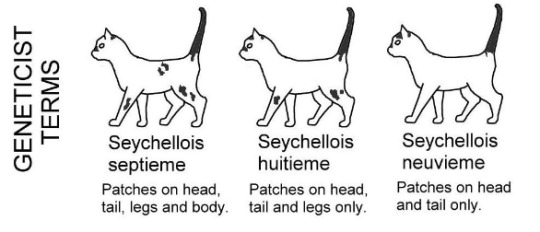
Unusual patterns (developmental)
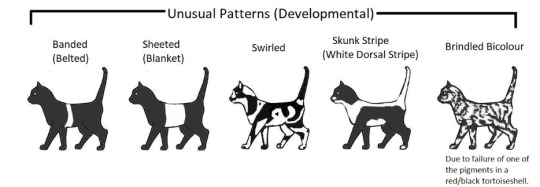
(Brindled Bicolour) Due to failure of one of the pigments in a red/black tortoiseshell.
Roan patterns
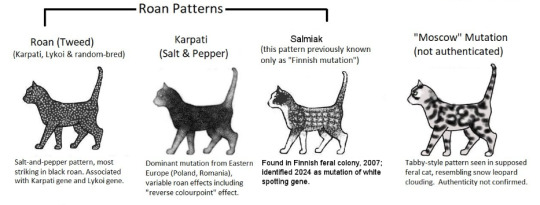
Salt-and-pepper pattern, most striking in black roan. Associated with Karpati gene and Lykoi gene.
Dominant mutation from Eastern Europe (Poland, Romania), variable roan effects including "reverse colourpoint" effect.
Found in Finnish feral colony, 2007; Identified 2024 as mutation of white spotting gene.
Tabby-style pattern seen in supposed feral cat, resembling snow leopard clouding. Authenticity not confirmed.
Age/health related
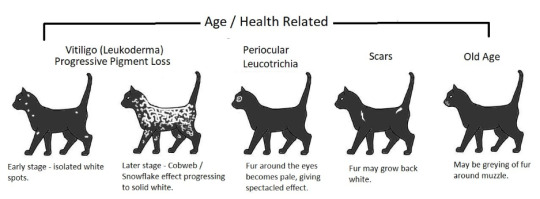
Early stage - isolated white spots.
Later stage - Cobweb/Snowflake effect progressing to solid white.
Fur around the eyes becomes pale, giving spectacled effect.
Fur may grow back white.
May be greying of fur around muzzle.
"Thai" white spotting gene (skunk stripe)

The Thai White Spotting pattern includes a white dorsal stripe and a white tail that may have a band or blotches of black. In Thailand, the pattern is called But-Se-Weis or But-Tal-Lon and various degrees of white—all with a dorsal stripe—are depicted in manuscripts. These patterns can also be seen in native Thai cats. The diagrams below show some of the variations.
Theories of how white spotting works - DISPROVEN
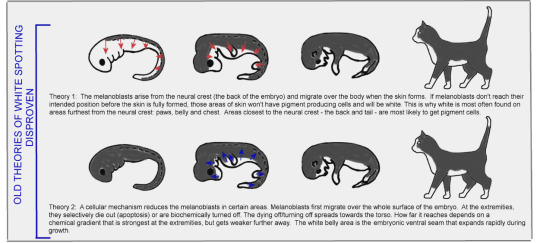
Theory 1: The melanoblasts arise from the neural crest (the back of the embryo) and migrate over the body when the skin forms. If melanoblasts don't reach their intended position before the skin is fully formed, those areas of skin won't have pigment producing cells and will be white. This is why white is most often found on areas furthest from the neural crest: paws, belly and chest. Areas closest to the neural crest—the back and tail—are most likely to get pigment cells.
Theory 2: A cellular mechanism reduces the melanoblasts in certain areas. Melanoblasts first migrate over the whole surface of the embryo. At the extremities, they selectively die out (apoptosis) or are biochemically turned off. The dying off/turning off spreads towards the torso. How far it reaches depends on a chemical gradient that is strongest at the extremities, but gets weaker further away. The white belly area is the embryonic ventral seam that expands rapidly during growth.
Theory of how white spotting works - PROVEN

The White Spotting gene affects the embryo melanoblasts which become pigment-producing skin cells (melanocytes).
Theory 3: For high grade
white spotting there may be another mechanism that produces jigsaw-like patches. First the melanoblasts migrate evenly across the skin surface. Then the expanding skin surface "cracks" during early embryo growth. Cracks break up the coloured surface into islands. The islands drift apart over the embryonic surface as the embryo grows. White areas form between the coloured islands. The white areas are like scar tissue and there are no more melanocytes available to fill them in. Some islands can get pushed together to create a mask-and-mantle pattern. It's similar to how continents moving on the Earth's surface. The white belly area is the embryonic ventral seam that expands rapidly during embryo growth (or it is the limit of melanocyte migration). Black feet are black islands that get pushed to the foot extremity by the expansion of the belly region the same time that limbs were forming.
CREDITS TO MESSYBEAST CATS
#cats#cat fact#cat drawings#cat facts#piebald cats#piebald#science#theories#interesting#biology#genetics#cat patterns#white spotting gene#cat genetics#cat science#mutation#cat mutation
17 notes
·
View notes
Note
seal point drusilla is extremely real omg now i wanna make my own buffy cat designs <- guy who has yet to post their torchwood cats
okay i'm gonna bounce ideas off you. i like the blotched on your buffy so i'm thinking cream blotched for her and maybe cream smoke for spike?

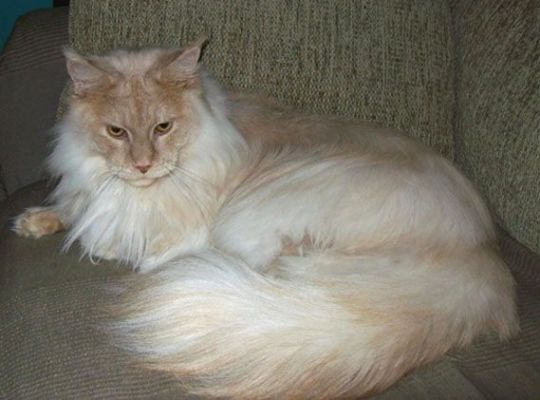
red willow. for obvious reasons. i'm thinking solid, maybe also with a blotched pattern, probably with white. xander.... black tabby? bicolor? yeah i think that works. mackerel, probably

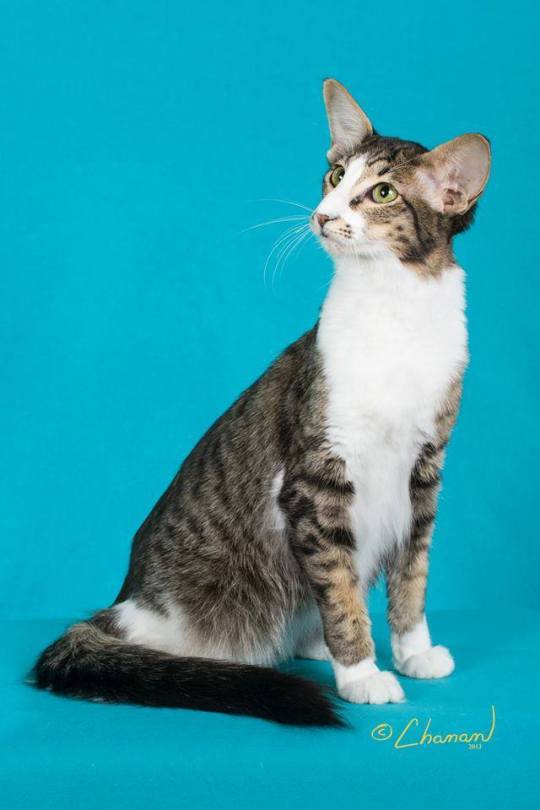
dru is a seal point, like you said. angel could be black bicolor or black blotched tabby with white, or possibly even blue tabby? i couls also make him silver. hmm



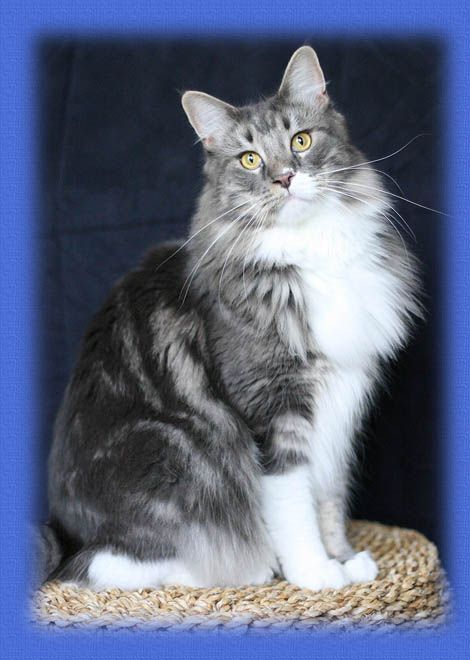
anya would also be cream, i think i'd go mackerel for her. giles is probably a black tabby with white, but i need to think on the pattern. another blotched? maybe.
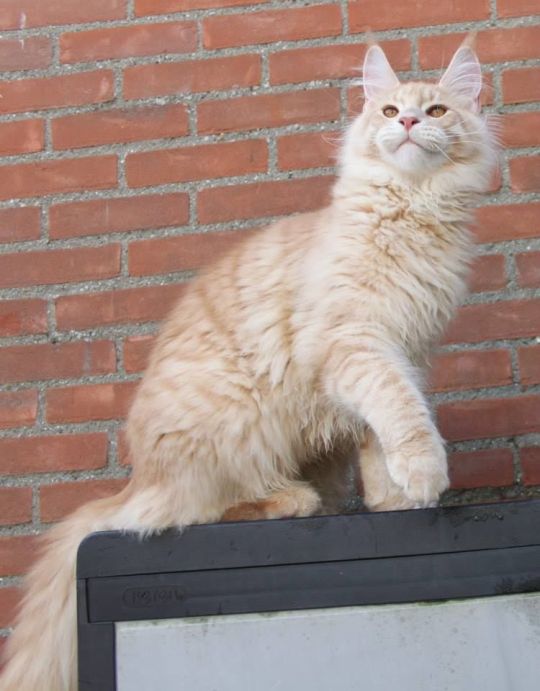
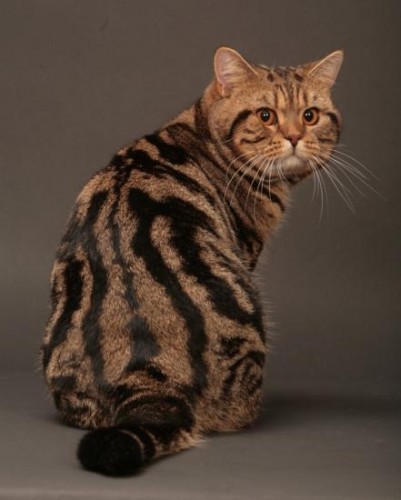
all these cats and not a single tortoiseshell.... maybe i'll make dawn a tortie. blue tortoiseshell dawn sounds like fun. that means joyce also has to be a tortie. but i'm not allowed to put any more pictures in here. sad. anyway i'll stop annoying you now <3
(btw i'm ignoring all breeds in the pictures they're just for the colours)
These are all so real. I actually did have a lighter design for Spike that I used for a while, but I changed it because it wasn't vibing quite right with me. I went darker with him because I wanted to incorporate the fact that he's big evil dark vampire ooo, and also the fact that he's got naturally darker hair and shouldn't have gotten his hands on the bleach.


I also thought about making Willow an orange cat, but I decided on tortie because a) I haven't done many tortie designs and I love, and b) I wanted to incorporate a bit of black cat into her, since she's a witch.
I didn't mention it last time but I was also thinking some variation of a tabby design for Cordelia too, but still gotta think about that.
9 notes
·
View notes
Text
Warrior cat clans' appearance traits (non-canon). Update when I understand actual cat genetics
WINDCLAN:
BODY/FUR TYPE: thin/tall, short thick fur, large pointed ears
COLORS: black, diltute black (COMMON white spotting)
PATTERNS: tuxedo, color point
THUNDERCLAN:
BODY/FUR TYPE: big/short, short thin fur, small pointed ears
COLORS: tortoise shell, chocolate (tortie), cinnamon (tortie), golden, reds, dilute blacks, (RARE white spotting)
PATTERNS: ticked tabby, tortoiseshell is usually heavy brindle
SHADOWCLAN
BODY/FUR TYPE: small/short, long thin fur, large rounded earsCOLORS: blacks, brown, reds (always dark) (NO WHITE)
PATTERNS: solid, agouti
RIVERCLAN:
BODY/FUR TYPE: thick/tall, long thick fur, small rounded ears
COLORS: blues, dilute reds, dilute tortoiseshell, silver
PATTERNS: mackerel tabby, blotched tabby, spotted tabby, tortoiseshell usually patched
Bloodclan and Skyclan are too mixed for unique traits.
3 notes
·
View notes
Note
Telly I see you talk about your kitties often and I was wondering if you have a designated kitty reference post? I wanna know more about your lil creatures c:

@thebardisabird Ahh I don’t have a reference post, but I definitely want to make one now! With pictures and everything. Maybe even a sideblog only for pictures of them, since there’s no shortage of animals around here, heh (for people who don’t know it yet, my parents run an animal shelter out of our family home since I was a kid!)
But I can list them all and some basic info about them so you guys can know who’s who for now:
Cats who live in my room + the catio area:
Cobalto (blue lynx point tabby, male)
Turquesa (blue and white, female)
Royal (blue and white tabby, female)
Celeste (colorpoint and white, female)
Safira (black and white, female)
Petróleo (black, male)
⬆️ These six are siblings!
Soufflé (long haired black and white, male)
Quiche (tabby and white, male)
⬆️ Those two are brothers!
Pistache (long haired tortoiseshell, female)
Pretzel (black, female)
Napoleon AKA Leon (tabby and white, male)
Ganache (long haired black smoke and white, female)
Bombom (long haired black smoke, male)
⬆️ Those two are mother and son!
Cats who live in the kitchen area + my mom’s room:
Chaves (black, male)
Susuwatari AKA Susu (long haired black, male)
⬆️ Susu is Chaves’ father and Chaves is Pretzel’s father!
Sirena (tabby and white, female)
Nemo (tabby and white, male)
⬆️ Those two are mother and son as well!
Saga (tabby and white, male)
Frodo (tabby and white, male)
Savannah (blotched tabby, female)
Tiffany (blue, female)
Domino (calico, female)
Lollipop (colorpoint and white, female)
Francine (colorpoint, female)
⬆️ She’s Leon’s mother!
And that’s all of them! There’s the dogs as well and my two rats but if I were to list them all here this post would be a mile long.
6 notes
·
View notes
Text
The Fascinating World of Cat Coat Patterns: A Look at What Makes Each One Unique
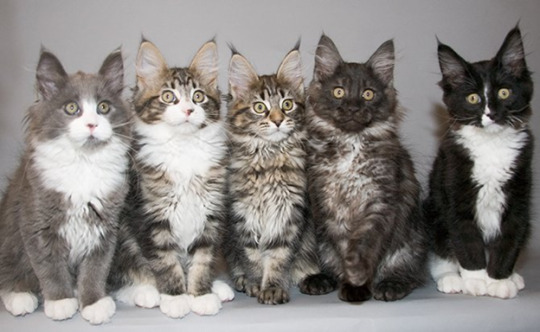
Introduction
Welcome to our exploration of the diverse and enchanting world of cat coat patterns! Cats capture our hearts and imaginations with their myriad colours and patterns. But have you ever wondered which cat coat pattern is the most popular or sought-after? In this journey, we'll delve into the beauty and uniqueness of various cat coat patterns, from the sleek solid black to the intricate tabby and everything in between.
Whether you're a cat lover, a curious reader, or considering adopting a feline friend, join us as we uncover the charm and popularity of these feline coat patterns, piecing together what makes each one special in the eyes of cat enthusiasts worldwide.
Common Cat Coat Patterns and Colors
Determining the most popular cat coat pattern involves different factors, including commonality, adoption rates, and people's preferences. Cats' various coat patterns and colours are uniquely appealing, influenced by cultural perceptions, breed characteristics, and individual preferences.
Solid Black: These cats are quite common but face a challenge in adoption due to superstitions. Nonetheless, their sleek and sophisticated look is appealing to many.
Solid White: Known for their bright, eye-catching coats and often having green or blue eyes, solid white cats are visually striking. However, many white cats, especially those with blue eyes, maybe deaf.
Tabby: is the most recognisable pattern, seen in various colors and featuring stripes or swirls. The primary tabby patterns include orange and grey, with additional sub-patterns based on stripe location.
Tortoiseshell: Featuring a mix of black, orange, and white patches, tortoiseshell cats are mostly female due to the genetics of their colouration.

Calico: Similar to tortoiseshells, calico cats display a combination of black, orange, and white but with more distinct blotches and a predominantly white background.
Reverse Calico: These have the same colours as regular calicos but with reversed dark and light patches.
Blue: Cats with a blue (slate grey) coat are often found in breeds like the Russian Blue, British Shorthair, and Chartreux.
Red: A rarer colouration ranging from light orange to deep red-brown, often seen in tabby patterns rather than as a solid colour.
Smoked: These cats have fur that is white at the roots but darkens toward the tips, commonly seen in long-haired breeds like the Maine Coon.
Bi-Colour: Typically consisting of two colours, black and white, these cats often include tuxedo cats and can be found in various other colour combinations.
Popularity and Preferences
A survey by the University of California, Davis, showed that people attribute different personality traits to cats based on colour, indicating that colour can influence adoption and preference. For instance, orange cats were perceived as friendly, while tri-coloured cats were considered more intolerant.
The Discerning Cat website also lists tabbies, tortoiseshells, calicos, and colours as some of the cats' most common colour patterns, further highlighting the prevalence and likely popularity.
According to a survey by The Catnip Times, people's preferences for cat breeds (and potentially their coat patterns) may also correlate with their personality types, as defined by the Myers-Briggs framework. However, the survey noted a general preference for domestic shorthair cats, indicating a shift towards favouring mixed-breed cats over purebreds for reasons beyond just coat patterns.
Conclusion
While it's challenging to pinpoint a single most popular cat coat pattern, tabby, calico, tortoiseshell, and bicolour patterns are among the most common and widely recognised. These patterns are cherished for their aesthetic appeal and diversity in the feline world. Individual preferences for cat coat patterns may vary greatly based on personal experiences, cultural backgrounds, and even personality types, making every cat coat unique and appealing in its own right.
0 notes
Note


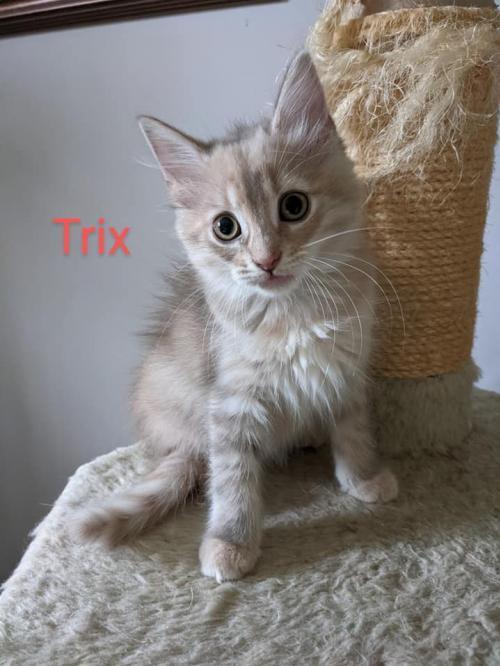

hi! i've been following your blog for a bit now and i love your posts about cat genetics. i was wondering if you could help me figure out the colors/patterns of these two pretty girlies.
for penny i was wondering if she could possibly be a diluted bengal since her spotted tabby markings look a bit rosetted.
for trix im not sure if she's a) a chocolate silver classic tabby/torbie or b) a fawn classic torbie. im leaning towards chocolate.
also here are the links to their profiles in case any of your followers are interested:
https://www.petfinder.com/cat/penny-53584807/fl/miami/furever-saved-fl1729/
https://www.petfinder.com/cat/trix-53333505/al/capshaw/forgotten-felines-inc-al143/
Penny is a beautiful red-spotted tabby with white, like this guy below!

from the photo you've sent, I'm not seeing anything that would indicate Bengal. I do see where you got confused because there are spot/stripes that are adjacent to each other in a way that could look connected, but that’s just how one copy of the spotted tabby gene + one copy of the mackerel tabby gene presents! rosettes have a dark outer outline and a light inner filling that is different from a cat’s ‘background’ colour
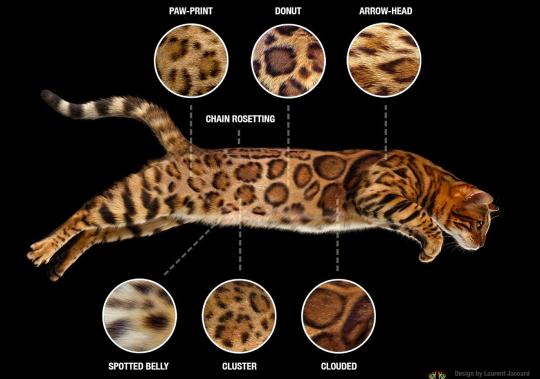
now onto Trix! fawn is a very rare colour, so unless the kitten is a purebred from a colour-oriented breed like Oriental Shorthairs, I wouldn’t consider that.
I don’t think she’s a chocolate silver torbie (chocolate + silver/inhibitor gene + tortoishell + tabby), because those tend to look darker and more.....well, chocolate!

she could be a blue silver torbie (dilute of black + silver/inhibitor gene + tortoishell + classic tabby), but her face looks quite light compared to the blue silver torbie below. it may just be the lighting in the photos, but none of the grey areas look particularly dark.

she’s pretty ambiguous, but I’m thinking lilac silver torbie? (dilute of chocolate + silver/inhibitor gene + tortoiseshell + classic tabby).
I wasn't actually able to find an example of this colouration online, but I did find a lilac silver tabby! if you pretend it has random blotches of cream areas, it does match up to Trix fairly well.

so you were very close with your chocolate silver torbie guess, just missing the dilution!
539 notes
·
View notes
Text
Here is an example of Medieval theme naming and roles! What do you guys think?
Allegiances of the beginning of the First Rise of Change Arc!:
Note: I tried to list the cats under each category in order of oldest to youngest.
THUNDER KINGDOM
Monarch:
Monarch Blue of Frost - short furred, tall, slender, solid blue-gray molly, with blue eyes and some white and a distinctive white diamond star shape on her chest.
Apprentice: Squire Fire
Advisor:
Advisor Red of tails - small, long furred, tortoiseshell tom with a distinctive ginger tail and orange eyes.
Apprentice: Squire Dust
Herbalist(s):
Herbalist Spotted of leaves - beautiful, fluffy, dark tortoiseshell molly with a distinctive dappled coat and orange eyes.
Captain:
Captain Lion the heart - large, fluffy, golden, ticked tabby tom with fluffy thick fur around his neck like a lion's mane and green eyes.
Apprentice: Squire Gray
Knights:
Senior Knight White the storm - long furred, gray tabby colorpoint tom with blue eyes.
Apprentice: Squire Sand
Senior Knight Tiger the claw - big, long furred, dark brown tabby tom with unusually long front claws and amber eyes.
Apprentice: Squire Raven
Knight Dark of stripes - fluffy dark gray tabby tom with dark black stripes and yellow eyes.
Knight Bird of flight - short furred, slender, brown tabby tom with some white and a distinctive white blotch on his chest, and upper lip, and green eyes.
Knight Willow of pelts - short furred, very pale solid gray and spotted cream molly with green eyes.
Knight Down the nose - short furred, tall, long limbed, white molly with distinctive large floppy ears and blue eyes.
Knight Cricket the step - very small, short furred, prettily handsome, white cat with black and orange calico patches and orange eyes.
Knight Mouse of furs - small dull brown ticked tabby molly with yellow eyes.
Knight Shrike of tails - tall, long limbed and tailed, pale brown tabby tom with dark black stripes with some white and green eyes.
Apprentices:
Squire Dust - buff, chubby, dark brown sepia color point tom with white on his muzzle, paws, tail tip, and as a small patch on his chest and purple eyes.
Squire Raven - small, scrawny, long limbed, solid black tom with a white patch on his chest, white-tipped tail, a scar over his left eye and purple eyes.
Squire Sand - a yellowy cream tabby and solid black tortoiseshell molly with a distinctive black marking covering exactly half her face and one orange eye in the black, and one green eye in the cream.
Squire Gray - fluffy, chubby, gray tabby tom with dark gray stripes, some white and orange eyes.
Squire Fire - a short, very chubby, handsome, long furred, bright ginger ticked tabby tom with some white and green eyes.
Queens:
Senior Knight Speckle the snap - long furred cream ticked tabby tortoiseshell with gray speckle patches on her back and covering her tail and golden yellow eyes. She is the oldest nursery queen.
Senior Knight Golden the flower - beautiful, long furred, golden cream tabby molly with golden yellow eyes.
Senior Knight Frost of furs - a sleek long furred, beautiful, white molly with a gray and orange tabby calico patch over one eye, and a mostly orange calico tail with one blue eye and one green eye.
Knight Brindle the beauty - short furred, gray-brown and orange tortoiseshell molly with green eyes and some white.
Elders:
Elder Small the ear - small, short furred white tom with orange tabby patches and battered torn ears and green eyes.
Elder Sparrow of pelts - big scruffy furred dark brown tabby tom with half of his tail missing and green eyes.
Elder Fog of talons - pale blue-gray molly, with some white, as well as one clawed out eye and one yellow eye.
Elder Thrush the cloud - medium furred, sandy brown ticked tabby tom with some white, and green eyes.
Elder Dapple of tails - round, chubby, short furred, white molly with black and orange calico patches and dappled spots and yellow eyes.
Elder Rose of tails - long furred, gray and red calico molly with a distinctive fluffy rosey red tail and yellow eyes.
37 notes
·
View notes
Text
Kelusine Species Sheet
BASICS
Name: Kelusine
Height: 2’6”-6’0” at the shoulder
Weight: 900~ lbs-2000< lbs
Diet: Carnivore
Classification: Planetary, Natural, Non-Magic Sensitive, Sapient, Feral, Feline
Trainable: Yes
Temperament: Territorial, Protective, Energetic, Playful
Danger Level: Medium
Lifespan: 170-180 Kelusian Years
Litter size: 2-4 cubs
BIOLOGY
Morphology: Immense felines, they are quite similar to the big cats of Earth aside from their strong saber teeth (which range from 4-8 inches) and thumb-like appendages in place of their dew claws. Males have lion-like manes whereas the females sport a short mane along the nape of their neck. In certain subspecies that reside in colder regions (Mountaineers and Wastelanders), the females’ manes may extend to their shoulders and belly.
Subtypes:
Islander: The swimmers and climbers. Found in low level coast forests in tropical regions and, as their name suggests, on island chains connected by shallow expanses of ocean. The smallest species, this cat resembles a Cloud Leopard in structure and their ankles can rotate backwards, just like the real life cat’s. This enables them to climb down trees headfirst, climb upside down, or even hang by their back feet. These cats reach only two and a half feet at the shoulder.
Plainer: The runners. The second smallest in shoulder height (4 ft), yet the second longest (14ish feet) thanks to their lengthy tail, Plainers are built purely for speed. Living on the wide open grasslands, they rely on quick bursts of speed to take down their prey. Their long tail acts like a rudder, just like a cheetah’s would, which enables them to make sharp turns with minimal warning.
Forester: The jack of all trades. An intermediate of the five subspecies (4 ½ feet at the shoulder), Foresters resemble the tigers of Earth in build. Strongly built without sacrificing speed, Foresters live in, you guessed it, forests. They prefer hardwoods with mixed pines, but can adapt to Alpine forests or mid-latitude jungles and woodlands.
Mountaineer: The jumpers. Closely resembling snow leopards or mountain lions, Mountaineers are found in similar environments; high altitude snowy mountains. Thick fur keeps them warm in the frigid air, and a thick tail helps them balance while chasing prey across steep slopes. Unlike snow leopards, however, Mountaineers are immense and rank #2 height (5ish feet) and #1 in length from nose to tail tip (16ish feet).
Wastelander: The bone crushers. Unlike the other subspecies, which have body types based primarily on existing big cats, Wastelanders get their inspiration from smilodons and grizzly bears. Built for pure power with strong shoulders and immense front paws, Wastelanders are the largest of all Kelusines with shoulder height measuring six feet and even seven in rare cases. They are also the only subspecies with a short tail.
Colors:
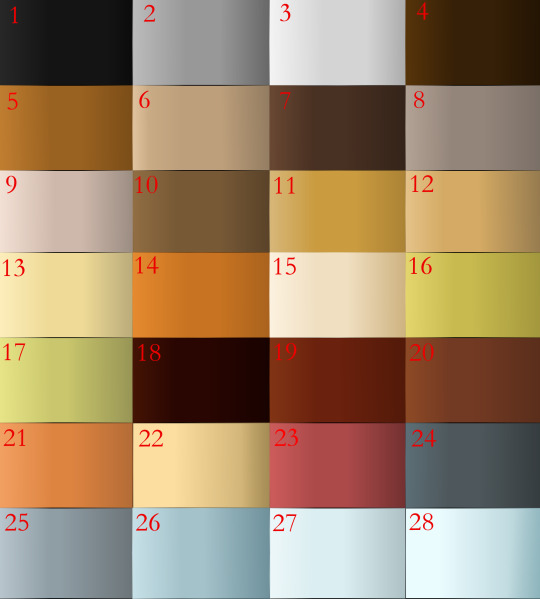
Standard:
Black
Grey
Silver
Brown
Light Brown
Tundra
Chocolate
Lilac
Fawn
Brown Ash
Golden
Tawny
Cream
Orange
Peach
Green Ash
Yellow Ash
Russet
Russet Brown
Cinnamon
Red
Strawberry
Red Ash
Blue
Blue-Grey
Chinchilla
Moonstone
Blizzard
Modifiers:
Colorpoint: Dilutes the base while leaving the extremities (face/tail/paws) normal
Reversal: Switches the color of the base coat and markings (ex: black with white stripes)
Light: Turns the inner marking of rosette/smeared/clouded/snow spot lighter than the base coat
Pied: White covers 25%-90% of the beast in solid patches
Splatter: White “paint splatters” cover 10%-50% of the beast
Tortoiseshell (Female only): The “red” gene is active and causes discoloration in patches.
Patterns:
Standard:
Common
Blotched Tabby
Brindle
Mackerel Tabby
Plain (no pattern)
Spotted Tabby
Ticked Tabby
Uncommon
Cheetah
Clouded
Dapple
Ocelot
Speckles
Rare
Double Dose (Spots on body and stripes on extremities)
Rosette
Snow Spot
Wild
Mutations:
Chimera (Two different base colors and markings)
Split (Two marking types)
Albino
Melanistic
Fallen Snow (Sabino along dorsal side)
Drift (Sabino along ventral side)
Glitch (Markings are broken and missing in some places)
Mist (Markings fade towards dorsal side)
Fog (Markings fade towards ventral side)
Storm (Markings in thin vertical bands)
Physical Mutations:
Mane:
Razorback (mane continues to tail)
Rimmed (mane along forelimb and back limb undersides; not found in Islanders or Plainers)
Curtain (long fur resemble horse mane; not found in Islanders or Plainers)
Static (Long and stiff along spinal area)
Scruff (Longer chin fur; standard Wastelanders)
Tail:
Bobtail (Stump)
Angel (longer silky fur)
Short (Akin to a wolf; standard for Wastelanders)
Ears:
Pointed (triangular rather than semi-circle; standard for Islanders)
Tufted (Lynx-like; standard for Wastelanders and Mountaineers)
Horned (Curl backwards)
Folded (Folded downwards)
HABITS
Habitat: Thanks to the abundance of specialized subspecies, Kelusines are one of the most diverse species in terms of location. They can be found almost everywhere apart from the far poles, deserts, and swamps. Large carnivores, they require an area rich in prey and thus control large swaths of territory either as a clan or as individuals.
Diet: Hypercarnivores, Kelusines require meat. They are not picky when it comes to meat, although shy away from carrion or cannibalism and a vast majority will not eat humans. One exception is the Wastelander subspecies, who will eat whatever prey they can catch. And humans are easy prey; dumb and slow.
Intelligence: Kelusines are one of the most intelligent animals of Kelusia. Like most creatures, they can speak Basic, or English. However, they are one of the few species that can learn languages other than their own and Basic. Kelusines are also one of the few that can operate high level technology. Some actually possess a Communication Watch on their wrists. Able to comprehend advanced math and science, Kelusines still prefer subjects that deal with history, natural science, and technology.
Social Life: Social creatures, wild Kelusines often live in small prides that consist of 5-7 individuals. However, sometimes to expand their territory, prides will join and make larger groups, or clans, of around 10-20 individuals, depending on the amount of prey available. When in clans, Kelusines have a ranking system to help things flow smoothly within the clan. The “head” positions are the Leader, Medic, and Deputy. Below that is the bulk of the clan, divided further into equal subgroups: Scouts, Operators (tech), Hunters, Guards, Milk Givers, and Elders. Below that rank the Trainees, who are the Kelusines ages 4-12 years, and finally come the Cubs, or Kelusines under the age of 4.
Life Cycle: Kelusine females carry for 9-10 months. There are 2-4 cubs in a litter, on rare occasions 5. The cubs are born helpless and cannot see or hear a week after birth. It is not uncommon for an expectant mother who resides alone to seek out a clan who will let her stay with them the first week or so after her cubs’ birth. She does this to ensure that her cubs are not killed by a rival or possibly a jealous male.
At two weeks, Kelusine cubs are stumbling around on stubby, unsteady legs. By now they can hear and see. They resemble fluffballs on sticks, their fur soft as down feathers. At three weeks, they can walk on their own without trouble and are play fighting with littermates or cubs near the same age if there are any. Around two months they are introduced to solid food. However, they continue to nurse until they are 9 months. At two years they begin to learn how to hunt for their own prey. They are usually taken out by both their mother and father if in a clan. If not, the mother or an older sibling will take them.
Kelusines are considered cubs until year four. By that time they are the size of a teenage tiger or lion. From year four to twelve they are considered adolescents. By now they are about the size of an adult lion or tiger. During the teenage years, Kelusines’ manes begin to grow. Their saber teeth also grow longer and stronger. Unless they grow up as rouges or loners, Kelusines begin to learn the basics of fighting at age twelve. If they were born outside of a clan, Kelusines often learn to fight sooner.
At sixteen years, Kelusines can make it on their own with no extra help. However, they are not considered full adults until age twenty. Females mature, both sexually and mentally, faster than males. They are considered mature at eighteen, while it takes males until year twenty. After a Kelusine reaches age twenty, they may leave to explore or may look for a job as a mount.
Kelusines are a unique species in that they are biologically immortal. The oldest Kelusine on record, a Forester by the name of Powerful Huntress of the Mountain Pass Pride, reached 220 Kelusian Years. However, most Kelusines only make it to 160-180 KY due to an oddity within their genes that becomes active around that age and produces similar symptoms to the viral infection rabies. Instead of intense fear, the Kelusine will become extremely aggressive, attacking anyone and anything in sight. This is not contagious, as it is not an infection, but there is also no cure for the affliction referred to as “Old Age Rage”. The only way to stop an OAR Kelusine is, unfortunately, to kill the beast.
Vocalization and Body Language: Like many of Kelusia’s unique fauna, Kelusines can speak Basic but also, as said earlier, have a unique ability to learn other languages such as Ragera. However, when they talk it is noticeably more guttural and rough compared to human speech. Aside from being able to speak “civilized” languages, Kelusines can make a wide variety of feral sounds. They have the ability to roar, snarl, growl, chuff, cough, groan, and hiss. Younger Kelusines can purr, but they do not have the ability to roar until age 5. Islanders and Plainers cannot roar no matter their age, but instead, like cheetahs, can purr through adulthood.
Kelusines are also heavily reliant on body language. Their body language heavily mimics the tigers of Earth. A calm Kelusine has a relaxed body posture, and the tail hangs languidly. When curious, their tail will be raised high in the air and their ears will be forward in interest. An aggressive Kelusine will bare its teeth, widen its mouth, enlarge its pupils, and flatten its ears.
OTHER
Ridability: Very human-like in their intelligence and readily available, Kelusines are not hard to come by. Kelusines are perhaps the most common mount as living with riders ensures a constant, easy food source while also making sure they get their exercise. That being said it is crucial for riders to understand Kelusines are not pets. Rather, they are companions who have agreed to carry the rider on their back. It is also important to keep in mind that, while Kelusines do have the intellectual capabilities of a human or higher creature, they are still highly dangerous predators who can turn on you if they so please. So treat them well.
Common Uses: Mounts, Guards, Guides, Rangers.
2 notes
·
View notes
Note
For the warrior cats ask game, how about Goldenflower/Tawnypelt/Bramblestar?

Goldenflower: blue tortie. Right now i prefer solid, but tabby could be good too. She can't be simply cream, because his sons both have black-based colors, and they needed to inherit a black allele from her for that.
Brambleclaw: black blotched tabby. I know some people like the idea of the "tigers" being mackerel, you know, tiger stripes, but the dark tabby description always made me think of blotched.
Tawnypelt: black tortie blotched tabby. I don't really like the solid calico design, sorry honestly i almost feel like the writers didn't know tortoiseshell without white is possible. So Tawnypelt is without white for me. Nobody has white spotting on her direct family tree anyway.



(warrior cats genetics ask game)
#ask and answer#warrior cats genetics#goldenflower#blue tortoiseshell#brambleclaw#black blotched tabby#tawnypelt#black tortoiseshell blotched tabby#cats
21 notes
·
View notes
Text
im not going to say it again
stripes, swirls, or uniform dotted array pattern = tabby
multicolor blotches of black, orange, and white, in an irregular, non-uniform arrangement across the body = tortoiseshell/calico
say it again for the people in the back
4 notes
·
View notes
Text
The Bengal Tabby Mix - General Information
New Post has been published on https://www.petculiars.com/the-bengal-tabby-mix-general-information/
The Bengal Tabby Mix - General Information
Although not among the most popular breeds of cats in the world, the Bengal cat is still recognized as one of the most athletic and active. With their muscled and lithe build, they will be able to jump very high in the air. Their complex physical appearance and their luxurious-looking coat are what make more and more pet owners in love with their looks. But before you buy it, is there any way of finding out of you’re getting a purebred or a Bengal tabby mix?
Bengal Tabby Mix: How to spot it
Tabby is not a specific breed but a coat pattern, which makes spotting a Bengal tabby mixed cat a pretty easy job. A tabby cat regardless of its breed will have stripes around the legs and tail, along its back, and also around the cheeks and eyes, and a very noticeable M-shaped marking on its forehead. Tabby cats, although different across breeds, will almost always be very smart, affectionate, and friendly with close people.
You might also like my articles on why would a cat have black boogers, why you shouldn’t cut a cat’s whiskers, and why won’t a cat eat prescription food.
Currently, there are five tabby patterns that are more popular, and these are:
The Spotted tabby – This cat will have either small or large spots all over the sides of its body, sometimes being very similar to mackerel stripes.
The Patched tabby – A cat that is usually known as either a tortie tabby or a tortoiseshell, with individual patches of red and brown tabby patterns. A tortie cat that also comes with tabby genes will be called a torbie.
The Ticked tabby – This type of cat won’t have too well-known traditional spots or stripes, except for some tabby markings on its face and some hairs that are striped with alternating dark and light bands.
The Mackerel tabby – This is what most people will call a tiger cat, with narrow stripes coming down in parallel on the sides in a vertical pattern. These stripes will usually look just like a fish skeleton.
The Classic tabby – This is the most common tabby and will have swirling patterns on the sides, similar to a marble cake. This cat is also known as a blotched tabby.
But what about the Bengal cat breed? What are its main physical traits and behavior particularities?
Bengal cats were made by crossbreeding the Asian leopard cat with a domestic cat to create a more obedient specimen but with an exotic appearance and a unique coat pattern and color. These cats are usually medium to large in size. The first time this cross between breeds was attempted was in the United States of America, around 1960. Except for the whisker pad, the chin, and the belly area, a Bengal will usually have no other white spots on its body. Instead, it will have a really nice-colored pattern. The tip of its hair strands will usually contain less pigment, which means that when light hits it, it will sparkle. The fur is pelted or soft and strands are individually ticked.
Common physical traits
Body length: 14 to 19 inches
Height: 8 to 10 inches
Weight: 12 to 16 pounds
Lifespan: 9 to 16 years
Coat length: short
Patterns: spots, ticking, tabby, rosettes (clouded, cluster, arrowhead, donut, paw print, spotted)
Colors: red, torbie, blue, cinnamon, black, seal, brown, silver, snow, or smoke
Eye color: orange, yellow, brown, or blue
You will notice that Bengals have a thick tail, large feet, and a thick neck, but also a triangular-shaped head. With a medium-length leg, they have really strong muscles they count on.
Personality traits and behavior
Although most people consider that Bengal cats are closer to wild animals than other breeds of cats, if you were to buy a domesticated specimen or one that has been separated from the wild for a few generations, you will notice it is more affectionate, loving and sweet. They will get very close to their owners and will be loyal for all their lives. You will have to match their energy because they really like to run, romp and jump around. This breed is also very alert and curious. This means that you will have to be prepared for an agile, playful, and energetic pet.
Although these cats like to climb in high areas and jump all-around your home during the day, they are loving and will demand your companionship throughout the night. Their strong memory enables them to learn tricks pretty easily and they can be taught to do anything from opening doors, to high fiving, sitting, and lying down. They will also learn most human expressions and gestures easily. They love to play around water and are in no way aggressive unless trained like that. Their constant need for stimulation can be kept under control with the use of interactive cat toys that can offer the needed exercise to your animals.
So, how does one ascertain if their cat is a Bengal tabby mix?
Considering the factors discussed above, it is safe to presume that your cat is a Bengal tabby mix if it possesses the characteristics of a Bengal cat but also has a distinctive tabby pattern. You may check your cat’s color markings and patterns and compare them with the common tabby patterns mentioned above to have an accurate match. You may also consult a local breeder or your veterinarian to help you in determining if your cat is a Bengal tabby mix if you have doubts.
Is it safe to own a Bengal tabby mix cat in a home?
Are there any legal issues?
To answer both questions at once, it is not only legal, but also safe to own a Bengal tabby mix cat in the USA, but also in Australia and Europe, as long as your cat will be separated from its wild ancestor, the Asian leopard cat, for more than five generations. Even though the vast majority of US cities will have no issues with you owning this kind of cat, there are others, and I must say, they aren’t small cities, like Seattle, Hawaii, Connecticut, and New York City, that won’t allow you to get this type of cat, regardless of their filial stage.
Conclusion
You will usually recognize a Bengal cat due to its athletic build, luxurious coat, and very affectionate nature. These cats are very smart, agile, and amazing jumpers. You should look in your cat for physical qualities, behavior, and temperament traits to see if it is a Bengal tabby mix. It should also have the unique tabby patterns in her coat.
0 notes
Text
What Color Is Your Cat?
Domestic cats come in four main colors.
Red / Orange (x)

Light Brown (x)
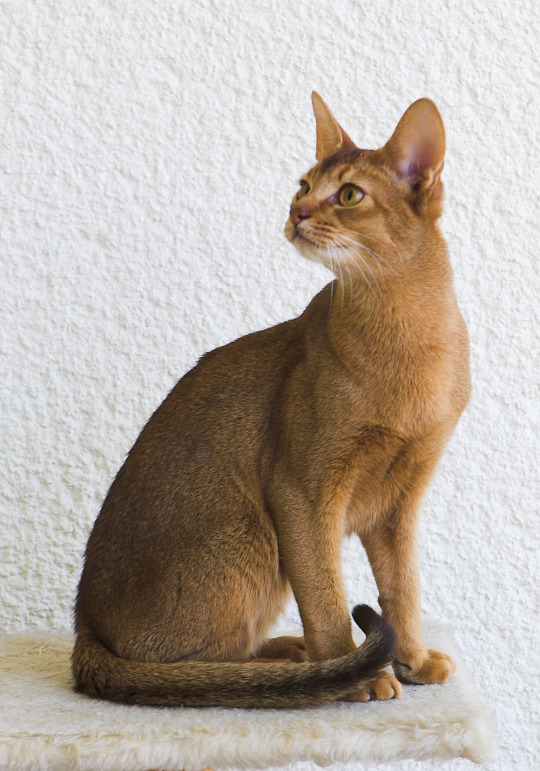
Dark Brown (x)
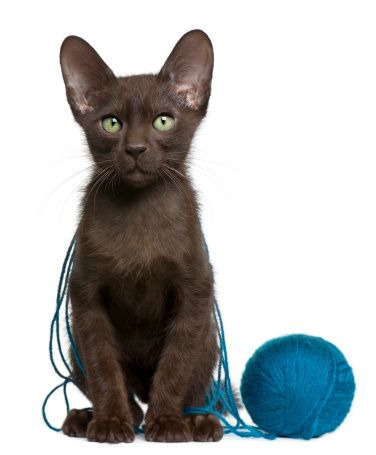
and Black (x)
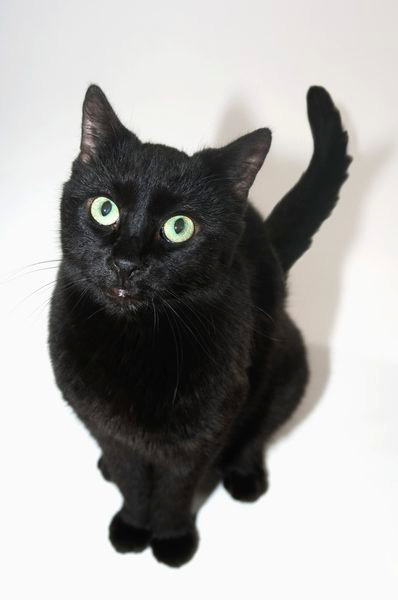
These four basic colors are the “deep” colors. This means the individual fur hairs have the color pigment all the way down the shaft. This creates a beautiful, “deep” color.
However, when the gene for agouti hairs is active, the pigment will instead gather in bands along the hair shaft. This creates a lovely “dilute” color that, to the naked eye, appears paler than the deep, nonagouti hairs. (x)
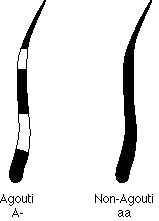
Instead of Red, you get Cream (x)
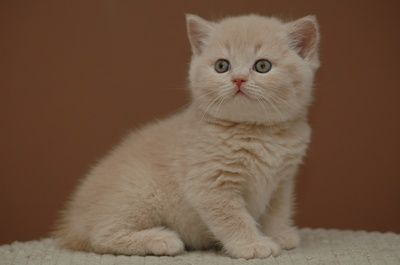
Instead of Light Brown, you get Fawn (x)
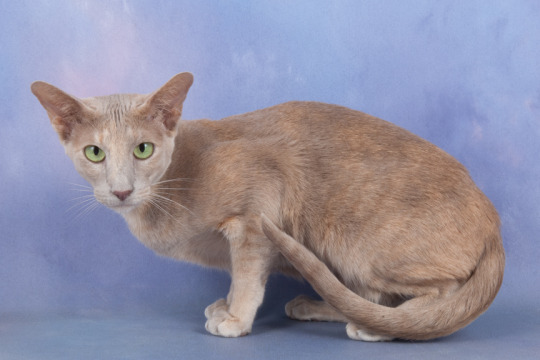
Instead of Dark Brown, it’s Lilac (x)
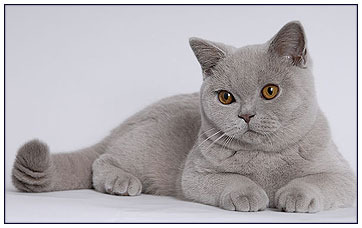
And instead of Black, it’s Gray / Blue (x)

There are also two special case colors. The first is white. White cats still contain the genetic markers for a non-white color, but the “white gene” masks that color and makes the hairs white.
The second special color is silver. A mutation that can happen to cats with any genetic color predisposition, it removes the yellowish or tannish pigment from the hairs, leaving them a beautiful silver instead. (x)

Except for black and gray, it usually takes special breeding to get a cat that is a solid color. Most cats will have a combination of colors and markings that makes them beautiful and unique.
Since they have a common ancestor in the African Wildcat, all domestic cats carry the gene for a tabby pattern. (x)
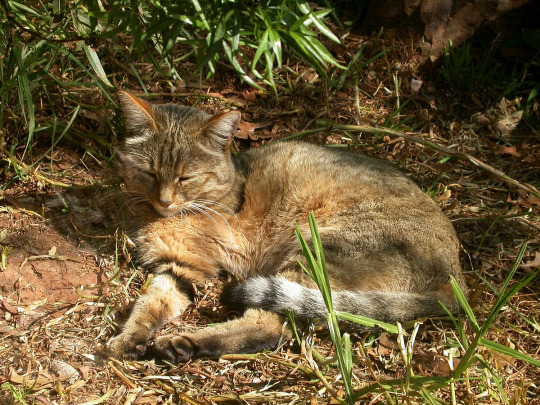
Even solid-colored cats will sometimes show a “ghost tabby” pattern under the right light, especially as a kitten. (x)
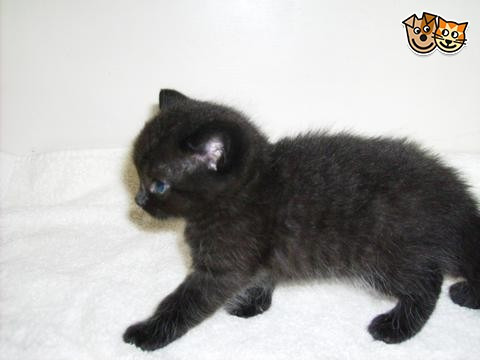
Patterns form when agouti hairs and nonagouti hairs gather in various patches, stripes, and dots on the cat. Where the nonagouti hairs gather, the cat will appear darker, and where there are more agouti hairs, the cat will appear lighter.
Is your cat a tabby?
As mentioned above, all cats carry the gene for the tabby pattern, though it is not always visible. There are four main kinds of tabby patterns.
Mackerel Tabby (x)
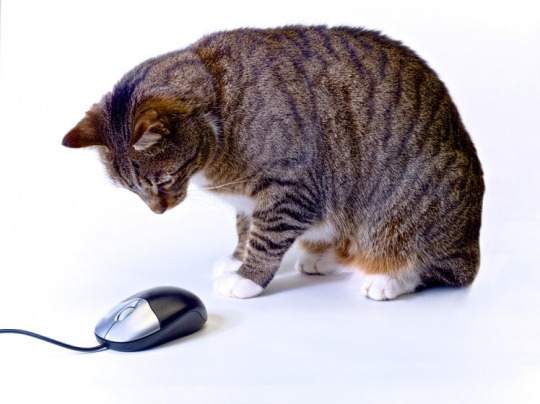
The original tabby pattern, it is so called because the stripes down the sides resemble the bones of a fish.
Classic Tabby (x)
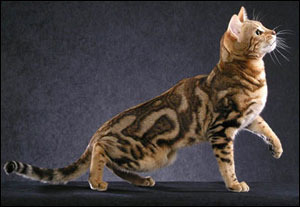
Also called a “blotched tabby.”
Spotted Tabby (x)

This pattern only rarely shows up in the domestic short- and longhair breeds. It usually requires special breeding to bring about.
Ticked Tabby (x)

A cat is considered a ticked tabby if her fur is almost entirely agouti hairs and has minimal visible pattern.
All tabby cats have an M shape on their foreheads. (x)
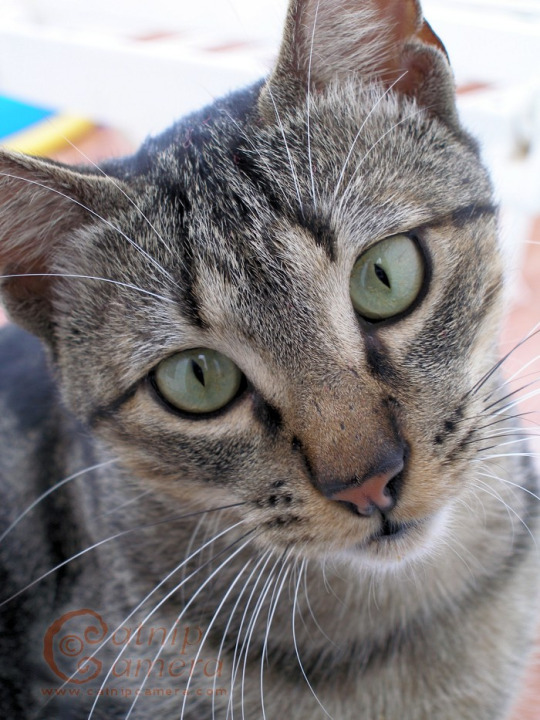
White patches? It’s piebald!
Piebald simply means your cat has white on it, but isn’t all white. There are different terms for piebald, or particolor, cats depending on the amount and placement of the white vs. the color.
Van (x)

Mostly white with patches of color mainly on the head and tail
Bicolor (x)
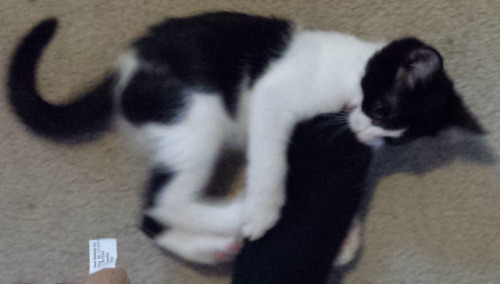
One to two thirds white, bicolor cats usually have color markings on their heads and torsos as well as tails.
Mitted (x)
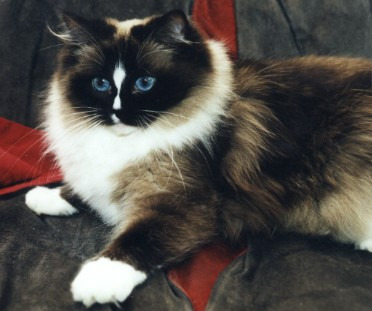
While mitted cats, obviously, have white on their paws, they can also have white on their chin, chest, belly, and back legs.
Lockets (x)
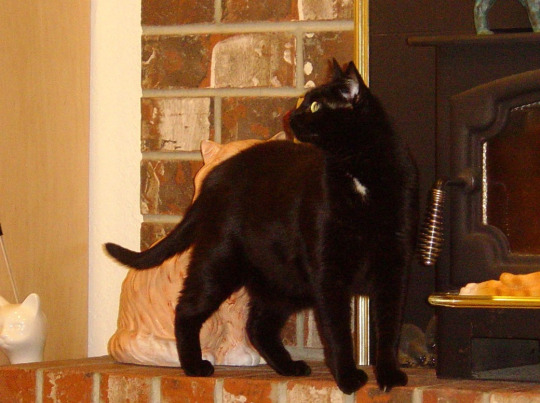
As you can see, the white patch looks like a locket on a necklace sitting on the chest. Small white patches can also be referred to as “buttons” and appear in other places on the body.
But wait... My cat is more colorful than that!
Tortoiseshell, or “Tortie,” patterns appear when a cat has two different color genes in her DNA and neither is dominant over the other. These colors are usually red and black, though other combinations can appear as well. Since the color gene is carried on the X chromosome, only female cats can exhibit tortie patterns. (The exception being an XXY intersex condition, but those males will be infertile.)
There are several tortie patterns...
Tortoiseshell (x)
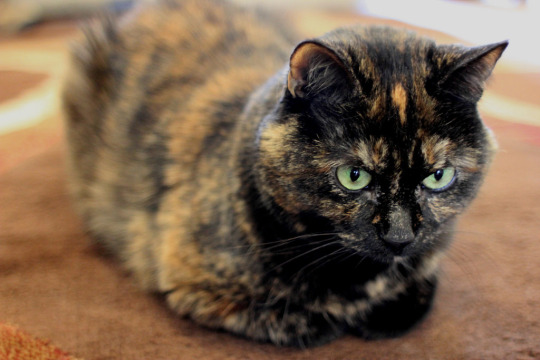
Classic red and black. Beautiful!
Calico (x)

When a tortie has patches of white, she’s called a calico.
Torbie (x)
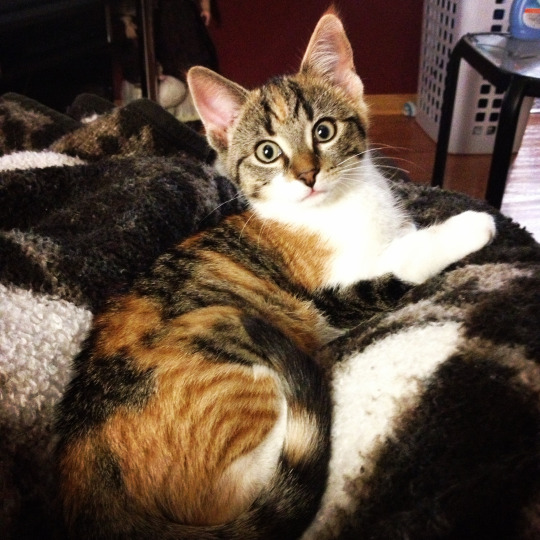
A tortie cat with a visible tabby pattern is called a torbie or patched tabby.
Pointed Cats
They’re not sharp and pointy--well, not more than any other cat. No, the term “pointed” refers to the fact that these cats have light-colored bodies with darker color appearing only at certain “points.” (Yeah, I would’ve come up with a better name too, but it’s stuck now.)
When thinking of a pointed cat, most people will think of the Siamese cat breed. They are pointed, but not all pointed cats are Siamese.
Colorpoint (x)
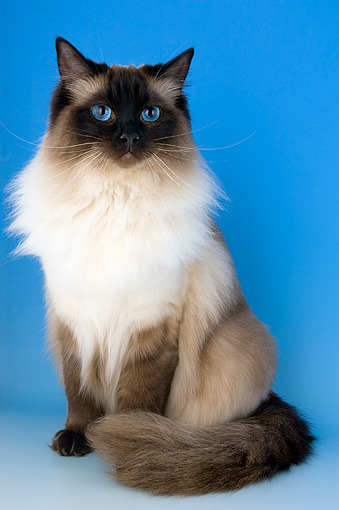
The darker patches are solid or unpatterned.
Tortie Point (x)
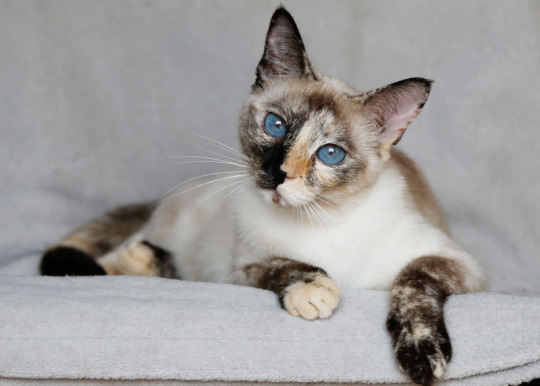
The darker patches have a tortie pattern.
Lynx Point (x)
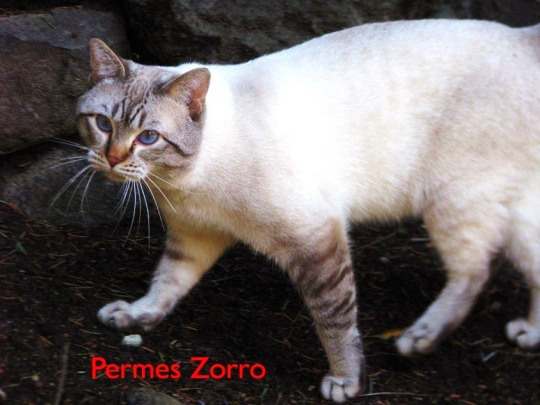
Lynx point patterns have stripes on the darker patches.
Tortie Lynx Point (x)

A combination of the tortie and lynx characteristics.
So, now that you have all the information you need, tell me
What Color Is Your Cat?
274 notes
·
View notes
Photo

Headshots of whatever Warriors character I felt like drawing.
I like to think Spottedleaf and Redtail are kind of tortoiseshell twins, except Spottedleaf is a spotted torbie and Spottedleaf is mostly black while Redtail is mostly red. I don’t know why but I thought Willowbreeze looked nice as a lilac silver tabby. And Hollyleaf with little blotches.
#hawkfrost#hollyleaf#nightcloud#spottedleaf#redtail#willowbreeze#warrior cats#stream can't draw#thunderclan#riverclan#windclan
5 notes
·
View notes